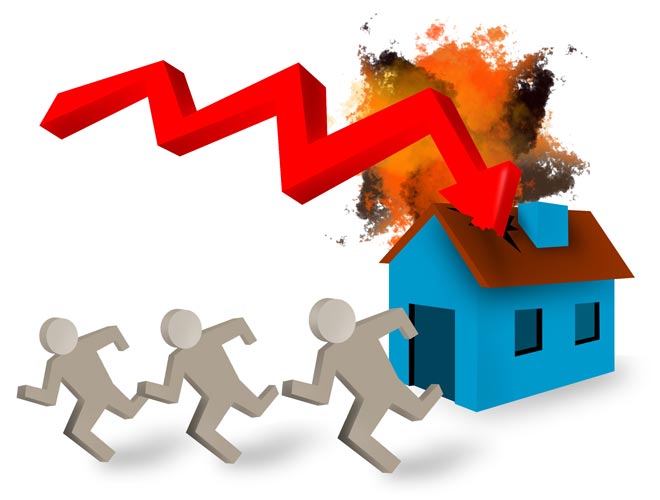From The Australian Financial Review.
More than 30,000 households in the nation’s wealthiest suburbs are facing financial stress, with hundreds risking default over the next 12 months because of soaring debts and static incomes, according to analysis of the nation’s household financial hotspots.
Hundreds of households in Sydney’s harbourside Vaucluse, where the median property price is $4.5 million, or Melbourne’s bayside Brighton, where a median priced house is $2.6 million, are being severely squeezed as costs continue to stretch incomes, the Digital Finance Analytics research finds.
“A lot of people making seriously good money have borrowed serious amounts of money. The one thing that sorts them out is when interest rates begin to rise,” said Christopher Koren, a buyers’ agent for Morrell and Koren, which specialises in top-end real estate.
“When it comes to top-end household cash flow – ‘Houston, we have a problem’,” said Martin North, principal of Digital Finance Analytics, who claims lenders are making incorrect assumptions about household incomes rising to meet increasing costs.
The analysis reveals that nearly 1000 households in Brighton, where a beachbox without electricity sells for more than $320,000, are under distress, or could face default in the next 12 months. Joe Armao, Fairfax Media.
The Reserve Bank of Australia this week warned property buyers stretching to enter the property market when interest rates are at record lows could be “vulnerable” to economic shocks, such as rate rises or a change in personal circumstances.
The bank’s research shows that debt for the nation’s top 20 per cent of households is at least 190 per cent of income, an increase of more than 50 per cent in the 12 years to 2014, the latest Reserve Bank of Australia numbers.
Brendan Coates, Australian Perspective Fellow for the Grattan Institute, said top-end debt is likely to have risen even higher during the past three years.
By contrast, debt for the bottom 20 per cent has remained at 60 per cent of total income.
Mr North said: “The banks have been very free in their lending to affluent households.”
Higher end is more exposed
It is based on traditional lending models that indicate lower income earners and the mortgage belt property buyers are the most vulnerable if rates rise, or the economy slows.
“But they have missed the point that massive leverage at the top end, static incomes and the high proportion of affluent households with interest-only loans means the higher end are significantly more exposed,” he said.
“A lot also have multiple households. Because rents are based on incomes, are lot of these investments are under water, which means they are losing money,” he said.

According to SQM Research, which monitors rents and house prices, the national average rental income for apartments is about 1.4 per cent and 2 per cent for houses, compared to 2 per cent inflation and interest rates typically about 4.5 per cent for investor loans.
Some investors, particularly from Sydney, are selling up, releasing capital and buying cheaper investment properties, in places like Adelaide, according to market analysts.
A median property in Sydney’s metropolitan area, which sells for about $1 million, will buy two inner suburban properties in Adelaide.
Households are ‘stressed’ when income does not cover ongoing costs, rather than identifying a percentage of income committed to mortgage repayments, such as 30 per cent of after-tax income.
Those in “severe distress” are unable to meet repayments from current income, which means they have to cut back on spending, or rely on credit, refinancing, loan restructuring, or selling their house.
Mortgage holders under “severe distress” are more likely to seek hardship assistance and are often forced to sell.
The analysis reveals that nearly 1000 households in Brighton, where a beachbox without electricity sells for more than $320,000, are under distress, or could face default in the next 12 months.
More than 600 households in Vaucluse and Watsons Bay are under similar pressure.
RBA assistant governor Michele Bullock said regulators remain concerned about the high level of household debt, which is a result of low interest rates and rising house prices.
“High levels of debt do leave households vulnerable to shocks,” she said.
Mr Coates said rich households having the most debt provided some comfort for regulators comparing Australia’s potential vulnerability to an economic shock with the US, where those most exposed were poorer, sub-prime borrowers.
“The RBA is less worried because people who hold the debt are relatively well off,” Mr Coates said.
Anecdotal evidence suggests top-end earners are increasing their spending at the same pace as rising property prices.
“Many in Melbourne and Sydney think they are bullet proof,” said Mr Koren. “They’ve bought property in premium suburbs in the best performing markets in the world and they suddenly think they are always making money, despite earning the same amount of pay”.
Across the nation, more than 860,000 households are estimated to be in mortgage stress, with more than 20,000 in severe stress, or a rise of about 1 per cent to about 26 per cent to the end of August, the analysis finds.
About 46,000 are estimated to risk default, it finds.

